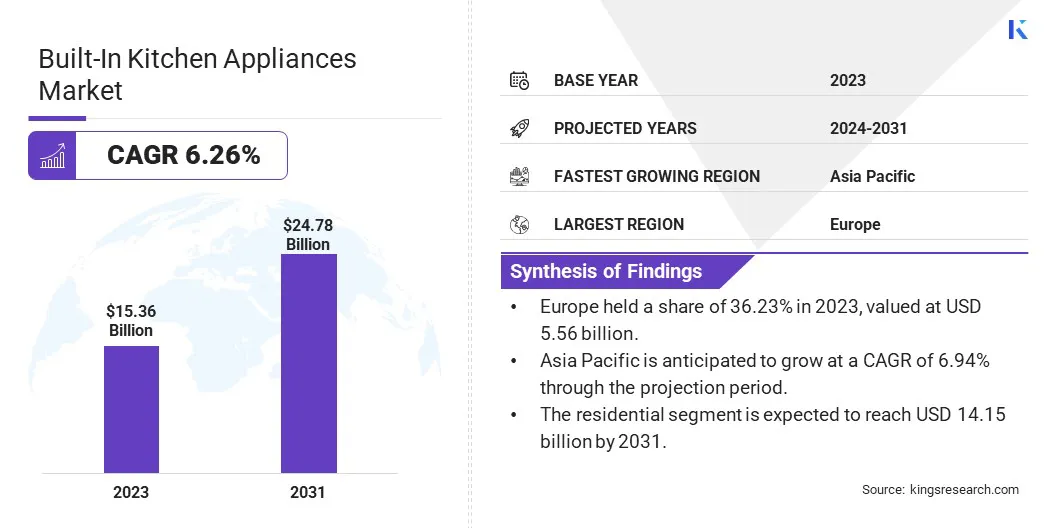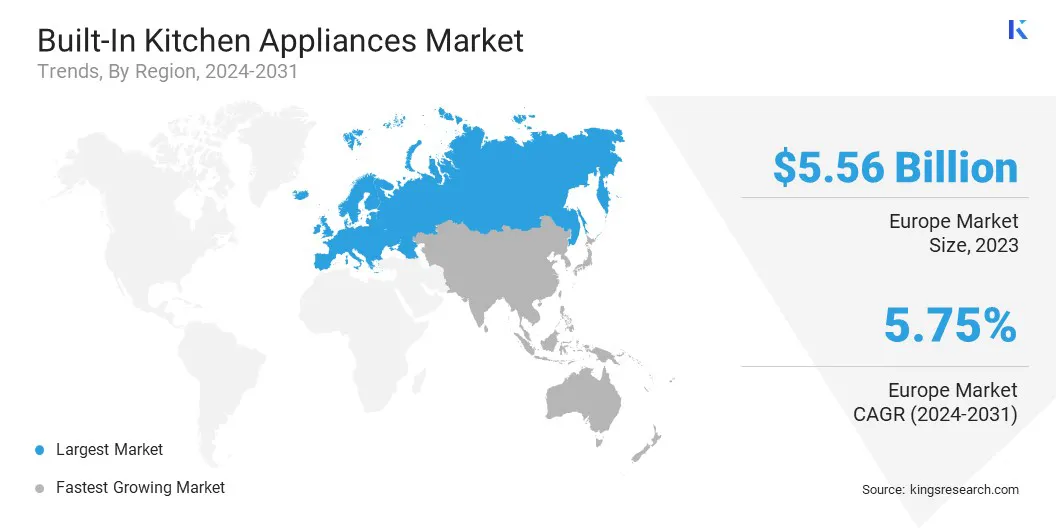Market Definition
The built-in kitchen appliances industry focuses on appliances designed to be integrated into kitchen cabinetry for a seamless, modern look. It includes appliances, along with installation, maintenance, and repair services.
Market growth is driven by consumer demand for space-efficient solutions, energy efficiency, and technologically advanced solutions that enhance both functionality and aesthetics in modern kitchens.
Built-In Kitchen Appliances Market Overview
The global built-in kitchen appliances market size was USD 15.36 billion in 2023, which is estimated to be valued at USD 16.20 billion in 2024 and is projected to reach USD 24.78 billion by 2031, growing at a CAGR of 6.26% from 2024 to 2031.
The rising demand for modern, aesthetic kitchen designs is boosting the growth of the market. Consumers increasingly prefer appliances that blend seamlessly with cabinetry, offering a sleek, integrated look while enhancing the overall kitchen's style and functionality.
Major companies operating in the built-in kitchen appliances industry are BSH Hausgeräte GmbH, Electrolux, Haier Inc, Whirlpool Corporation, Panasonic Industry Co., Ltd., LG Electronics, Elica S.p.A, SAMSUNG, Gorenje, Dacor, Inc., Miele & Cie. KG, JennAir, Franke Faber India Private Limited, IFB Appliances, Jyoti India Appliances PL, and others.
The market is characterized by a shift toward high-end, sophisticated solutions that combine functionality with design. Consumers are prioritizing seamless integration into their kitchen spaces, focusing on both aesthetics and efficiency.
These appliances are becoming integral to modern home design, reflecting a preference for premium quality, durability, and innovation. The market expansion is further propelled by demand for space-saving, high-performance solutions that enhance contemporary kitchen environments.
- In January 2023, Samsung unveiled new built-in kitchen appliances focused on customization and intelligent connectivity. These appliances, such as the Bespoke 4-Door Flex Refrigerator and Bespoke AI Oven, offer enhanced user experiences with AI-powered features, larger screens, and improved energy efficiency, aligning with the growing demand for personalized, smart kitchen solutions.
 Key Highlights:
Key Highlights:
- The built-in kitchen appliances market size was recorded at USD 15.36 billion in 2023.
- The market is projected to grow at a CAGR of 6.26% from 2024 to 2031.
- Europe held a share of 36.23% in 2023, valued at USD 5.56 billion.
- The built-in refrigerators segment garnered USD 5.52 billion in revenue in 2023.
- The residential segment is expected to reach USD 14.15 billion by 2031.
- The online retailers segment is anticipated to witness the fastest CAGR of 6.85% over the forecast period.
- Asia Pacific is anticipated to grow at a CAGR of 6.94% through the projection period.
Market Driver
"Rapid Urbanization"
Rapid urbanization is fostering the expansion of the built-in kitchen appliances market, as increasing migration to smaller city apartments fuels demand for space-efficient, integrated solutions.
- According to the World Bank Group, approximately 56% of the global population currently resides in cities. This figure is expected to exceed 70% by 2050 as urbanization continues.
The demand for built-in kitchen appliances is rising as consumers seek space-efficient, high-functionality solutions. The trend toward compact living, driven by increasing urbanization, is fueling market growth.
- In January 2023, Sharp Home Electronics Company of America showcased its latest appliance innovations at the Kitchen & Bath Industry Show (KBIS). They introduced the 30" gas and electric convection slide-in ranges, and 30" smart combi appliances, featuring modern designs, advanced cooking modes, and smart technology. These high-performance, built-in solutions enhance functionality, connectivity, and user experience, catering to consumers seeking premium kitchen appliances.
Market Challenge
"High Initial Costs"
A significant challenge impeding the growth of the built-in kitchen appliances market is the high initial cost, as these appliances often require a larger investment compared to standalone alternatives. This makes them less accessible to budget-conscious consumers, limiting their adoption.
To address this challenge, manufacturers can offer flexible financing options or discounts to enhance affordability. Additionally, producing more cost-effective models without compromising on quality or design can expand market reach.
Market Trend
"Ongoing Technological Advancements"
Technological advancements are emerging as a key trend influencing the built-in kitchen appliances market. Consumers are increasingly drawn to appliances that offer smart technology, such as voice control and app integration, allowing for seamless connectivity and convenience.
Additionally, energy-efficient features are in high demand, as they help reduce utility costs and environmental impact. User-friendly interfaces with intuitive controls are gaining significant popularity, making these appliances easier to operate and enhancing user experience, fueling the growth of the market.
- In April 2024, Samsung unveiled new Bespoke AI kitchen appliances, including 4-Door Flex refrigerators and redesigned slide-in ranges, featuring AI-powered technology and seamless connectivity. These advancements enhance meal planning, cooking, and grocery shopping, reflecting the growing trend of smart, energy-efficient, and user-friendly appliances in modern kitchens.
Built-In Kitchen Appliances Market Report Snapshot
|
Segmentation
|
Details
|
|
By Product Type
|
Built-in Ovens & Microwaves, Built-in Cooktops/Hobs, Built-in Hoods/Range Hoods, Built-in Refrigerators, Others
|
|
By Application
|
Residential, Commercial
|
|
By Distribution Channel
|
Direct Sales, Multi-Brand Stores, Specialty Stores, Online Retailers, Other Sales Channel
|
|
By Region
|
North America: U.S., Canada, Mexico
|
|
Europe: France, UK, Spain, Germany, Italy, Russia, Rest of Europe
|
|
Asia-Pacific: China, Japan, India, Australia, ASEAN, South Korea, Rest of Asia-Pacific
|
|
Middle East & Africa: Turkey, UAE, Saudi Arabia, South Africa, Rest of Middle East & Africa
|
|
South America: Brazil, Argentina, Rest of South America
|
Market Segmentation:
- By Product Type (Built-in Ovens & Microwaves, Built-in Cooktops/Hobs, Built-in Hoods/Range Hoods, Built-in Refrigerators, and Others): The built-in refrigerators segment earned USD 5.52 billion in 2023 due to increasing demand for modern kitchen designs and multifunctional cooking solutions.
- By Application (Residential and Commercial): The residential segment held a share of 56.31% in 2023, mainly fueled by rising consumer preference for home upgrades and the growing popularity of smart, energy-efficient appliances.
- By Distribution Channel (Direct Sales, Multi-Brand Stores, Specialty Stores, Online Retailers, and Other Sales Channel): The specialty stores segment is projected to reach USD 9.09 billion by 2031, propelled by the growing demand for personalized in-store experiences and expert guidance in appliance selection and installation.
Built-In Kitchen Appliances Market Regional Analysis
Based on region, the global market has been classified into North America, Europe, Asia Pacific, Middle East & Africa, and Latin America.
 Europe built-in kitchen appliances market accounted for a share of around 36.23% in 2023, valued at USD 5.56 billion. This dominance is reinforced by a preference for high-quality, aesthetically designed products that integrate seamlessly into modern kitchens.
Europe built-in kitchen appliances market accounted for a share of around 36.23% in 2023, valued at USD 5.56 billion. This dominance is reinforced by a preference for high-quality, aesthetically designed products that integrate seamlessly into modern kitchens.
The region’s strong adoption of smart home technology and energy-efficient solutions further boosts demand. European consumers prioritize both functionality and design, creating a robust demand for built-in appliances, particularly in residential settings.
- In April 2024, LG Electronics unveiled its latest built-in kitchen appliances at Milan Design Week, targeting European consumers. The showcase featured the Signature Kitchen Suite built-in oven, free zone induction hob, and downdraft hood, highlighting innovative design, AI technologies, and premium features for an enhanced culinary experience.
Asia Pacific built-in kitchen appliances industry is set to grow at a CAGR of 6.94% over the forecast period. This growth is stimulated by rapid urbanization and increasing disposable incomes.
As cities expand and living spaces become more compact, the demand for space-saving and integrated kitchen solutions has surged. Countries such as China and India are experiencing strong growth, with rising middle-class populations seeking modern, smart kitchen appliances. Technological advancements and the growing trend of smart homes are accelerating the adoption of built-in kitchen appliances.
- In May 2024, Crompton Greaves Consumer Electricals Ltd. began manufacturing and assembling built-in kitchen appliances at its Vadodara, Gujarat, facility. This state-of-the-art setup supports Crompton's 'Make in India' initiative, enhancing quality and operational efficiency through advanced digital processes and automated systems.
Regulatory Framework
- In the U.S., ENERGY STAR is the government-backed symbol for energy efficiency, offering reliable, unbiased information to guide consumer and business decisions.
- In the EU, Ecodesign and Energy Labelling regulations uniformly apply across the Internal Market, improving the environmental performance of products such as household appliances, ICT products, industrial machinery, and tyres.
Competitive Landscape
The built-in kitchen appliances market is characterized by a large number of participants, including both established corporations and emerging players. Partnerships in the market focus on combining technological innovation, sustainability, and design excellence.
Companies collaborate to offer energy-efficient, smart, and user-centric products that align with evolving consumer demands. These strategic alliances enhance product offerings, expand market reach, and drive the adoption of cutting-edge features, delivering superior kitchen solutions to diverse consumer segments.
- In April 2024, Clayton Home Building Group partnered with Samsung Electronics America to feature Samsung's energy-efficient, design-forward built-in kitchen appliances in new homes. This collaboration emphasizes sustainability and innovation, addressing the growing demand for smart, eco-friendly kitchen solutions.
List of Key Companies in Built-In Kitchen Appliances Market:
- BSH Hausgeräte GmbH
- Electrolux
- Haier Inc
- Whirlpool Corporation
- Panasonic Industry Co., Ltd.
- LG Electronics
- Elica S.p.A
- SAMSUNG
- Gorenje
- Dacor, Inc.
- Miele & Cie. KG
- JennAir
- Franke Faber India Private Limited
- IFB Appliances
- Jyoti India Appliances PL
Recent Developments (Launch)
- In September 2024, AEG unveiled its largest kitchen range at IFA, featuring AI-assisted cooking technology, energy-efficient features, and striking design. The new range includes ovens, hobs, hoods, built-in coffee machines and dishwashers, delivering a premium cooking experience.
- In November 2024, Hafele launched a range of premium kitchen appliances, including the Midora Full Steam Oven, Renata Cookerhoods, and Altius Plus Hobs. These products incorporate cutting-edge technologies to enhance cooking efficiency while maintaining sleek, modern aesthetics.

 Key Highlights:
Key Highlights: Europe built-in kitchen appliances market accounted for a share of around 36.23% in 2023, valued at USD 5.56 billion. This dominance is reinforced by a preference for high-quality, aesthetically designed products that integrate seamlessly into modern kitchens.
Europe built-in kitchen appliances market accounted for a share of around 36.23% in 2023, valued at USD 5.56 billion. This dominance is reinforced by a preference for high-quality, aesthetically designed products that integrate seamlessly into modern kitchens.